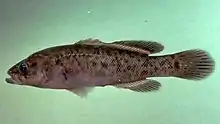Nightfish
The nightfish (Bostockia porosa) is a species of freshwater ray-finned fish, a temperate perch from the family Percichthyidae which is endemic to southwestern Australia.
| Nightfish | |
|---|---|
 | |
| Scientific classification | |
| Kingdom: | Animalia |
| Phylum: | Chordata |
| Class: | Actinopterygii |
| Order: | Perciformes |
| Family: | Percichthyidae |
| Genus: | Bostockia Castelnau, 1873 |
| Species: | B. porosa |
| Binomial name | |
| Bostockia porosa Castelnau, 1873 | |
| Synonyms[1] | |
| |
Description
The nightfish has an oblong and compressed body with a large, oblique mouth which has a slightly protruding lower jaw and which reached beyond the rear edge of the pupil. Both jaws and the roof of the mouth have bands of villiform teeth> It has an incomplete lateral line which has 43-47 tubed scales. There are large obvious open pores around each eye and along the upper part of head and along the jaws. The gill cover ends in a double spine. The dorsal fin contains 7 or 8 spines, spines 3 and 4 being the longest, and 16-17 soft rays, the spiny and soft-rated parts separated by a deep notch. The anal fin has 3 spines and 11-12 soft rays. The anal and caudal fins are rounded.[2] It is normally deep olive purple to black or dark-brown but can be light-brown with a dark brown mottling when living in lighter environments.[3] The maximum recorded standard length is 15 centimetres (5.9 in), although most fish are around 9 centimetres (3.5 in).[1]
Distribution
The nightfish is endemic to the coastal wetlands of Southwest Australia. It is common and is found between the Hill River, near Jurien Bay and the Kalgan River near Albany.[3]
Habitat and biology
The nightfish is found in coastal streams, lakes and ponds where they occur in both clear waters and in waters darkened by tannins. They prefer to be in the vicinity of the cover of rocks, macrophytes or submerged wood. It hides during the day, beneath stones or among vegetation.[1] The adults remain hidden in the daylight hours and emerge to feed at night while the juveniles are more diurnal. Males attain sexual maturity after a year and females after two years, when the water levels rise in the winter rains in August and September they migrate upstream to headwaters and tributaries to breed.[3] Each female can lay 230 to 1138 eggs. This is a carnivorous species which feeds on a variety benthic invertebrates, especially ostracods and fly larvae.[4] They have a lifespan of 6 years.[1]
References
- Froese, Rainer and Pauly, Daniel, eds. (2019). "Bostockia porosa" in FishBase. December 2019 version.
- Vanessa J. Thompson & Dianne J. Bray. "Bostockia porosa". Fishes of Australia. Museums Victoria. Retrieved 13 May 2020.
- "Nightfish Bostockia porosa". Government of Western Australia. Retrieved 13 May 2020.
- L.J. Pen & I.J. Potter (1990). "Biology of the Nightfish, Bostockia porosa Castelnau, in a South-western Australian River". Australian Journal of Marine and Freshwater Research. 41 (5): 627–645.